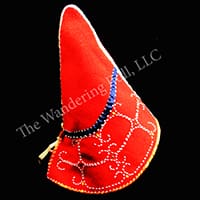

Women’s Hoods
Much has been written about the peaked caps – also known as hoods – that are worn by the Wabanaki people. Bruce Bourque and Laureen LaBar present illustrations of several of these hoods in their book “Uncommon Threads: Wabanaki Textiles, Clothing, and Costume”. But what are they?
First, we need to understand that Wabanaki Hoods were worn by both men and women. In this article, we will explore the women’s peaked hood.
Traditionally, these hoods draped down over the shoulders. Only women wear these hoods. Interestingly, people in cultures besides the Wabanaki wear similar headwear. In Spain, secret religious societies wear large peaked hoods during the week before Easter. In the Basque country, between France and Spain, women also wear a headdress similar to Wabanaki women.
We occasionally see these Hoods at Powwows in the Northeast today. When we do see them, they are made of wool. Typically they have a cotton lining and feature beautiful and elaborate beadwork.
Prior to contact, Native Americans in the Northeast made their Hoods with birch bark or leather. But few examples of Wabanaki peaked hoods made with either of these materials exist today. Post-contact, Europeans traded cloth to the Native Americans in exchange for furs. Thus, from that point on, garments made from wool or cotton fabric became an essential commodity.

Examples of Women’s Hoods
Pictured here is an example of a Wabanaki hood worn by a Mi’kmaw woman from of Nova Scotia. This drawing was made in the mid-19th century.[1]
An observation has been made that when the Wabanaki people lived in round houses (wigwams) their designs were more geometric. After they moved into more squared homes, their designs became more rounded – like the Double Curve motif. They incorporated these designs into their decorations of Women’s Hoods.

Another woman’s Hood from the mid-1800s incorporates Glass Seed Beads, Ribbons, and Ostrich feathers in its design. This clearly demonstrates the influence of European culture on Native American communities. This Hood is housed at the Fenimore Art Museum in New York (photograph by Richard Walker).[2]
Our last example of a Wabanaki Hood is contemporary. It comes to us from Abenaki artist Rhonda Besaw. Her creations clearly demonstrate the adaptability and resilience of the Wabanaki people. Her design includes the Double Curved motif as well as flowers.[3]

[1] Library and Archives Canada
[3] Photo courtesy of Rhonda Besaw.
By Jo-Ann Belanger
You can find Ready to Wear Hoods and Plain Hoods at The Wandering Bull! We also have Seed Beads available so you can decorate your own!


